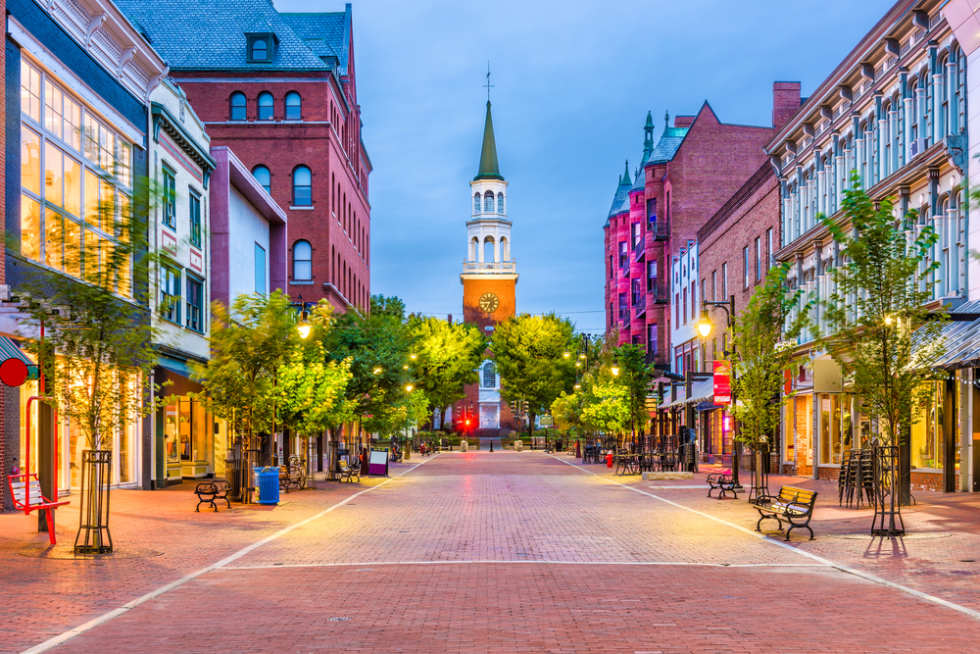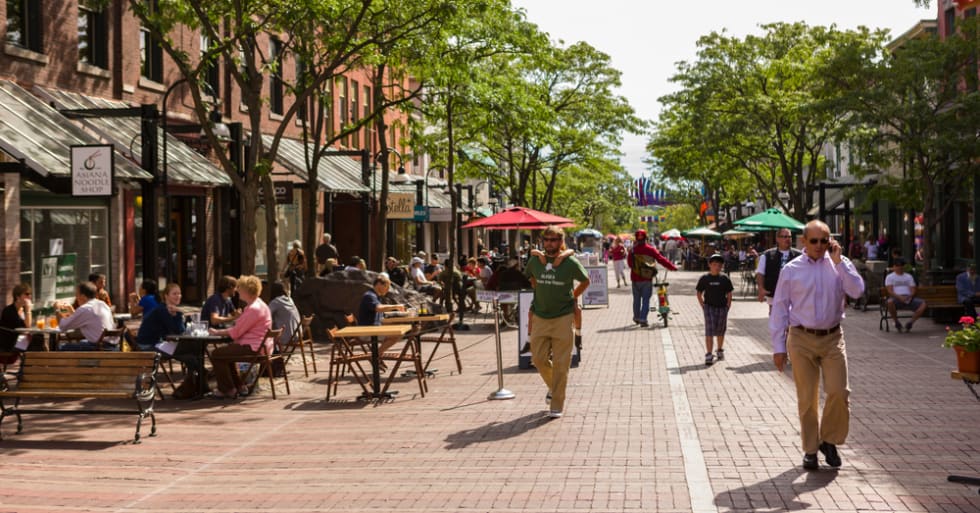44 Drew St
- 2 units available
- 3 bed • 4 bed
- Amenities
In unit laundry and Pet friendly

Vermont is called the Green Mountain State nickname for its majestic green mountains and natural forested beauty. With scenic hiking trails in the warmer months, the lush mountains turn into destination-worthy ski trails come winter.
Known for a wide range of goods, including maple syrup and cheddar cheese, Vermont is also the home of the famous Ben & Jerry’s ice cream. With so much to offer, it’s no wonder that U.S. News ranks Vermont #11 in Overall Rankings as the best state to live in.
However, before you pack your things and head east to Vermont, check out this apartment guide for some quick pointers. You’ll also want to do your homework to get a better idea of Vermont’s cost of living, which is why we made this guide to help you understand better what type of budget you’ll be needing.
The cost of living in Vermont is 0.8% higher than the national average, making it a relatively affordable place to live. Of course, where you live in Vermont will impact the cost of living. A large city will command higher rents while a more rural mountain town will offer more options for affordability.
Best Places broke down the data to give you a better idea of how Vermont compares to the rest of the United States in terms of the cost of living.
| Cost of Living | Vermont | U.S. |
|---|---|---|
| Overall | 100.8 | 100 |
| Grocery | 106.7 | 100 |
| Health | 128.5 | 100 |
| Housing | 100.8 | 100 |
| Median Home Cost | $344,600 | $338,100 |
| Utilities | 117.4 | 100 |
| Transportation | 77.9 | 100 |
| Miscellaneous | 110.1 | 100 |
Despite the higher cost of living in Vermont, there are categories that are relatively affordable, including housing and transportation.

The cheapest major city in Vermont is Rutland. It's cost of living is 9.9% lower than the U.S. average and 10.6% lower than the United States average. According to the data, the cost of living categories are lower across the board, except for groceries, healthcare, utilities, and miscellaneous.
| Cost of Living | Rutland | Vermont | U.S. |
|---|---|---|---|
| Overall | 90.1 | 100.8 | 100 |
| Grocery | 105.3 | 106.7 | 100 |
| Health | 128.2 | 128.5 | 100 |
| Housing | 71.8 | 100.8 | 100 |
| Median Home Cost | $208,800 | $344,600 | $338,100 |
| Utilities | 116.7 | 117.4 | 100 |
| Transportation | 63.3 | 77.9 | 100 |
| Miscellaneous | 107.7 | 110.1 | 100 |
The most expensive city in Vermont are ski and tourists town, including Burlington, where the cost of living is 12.4% higher compared to the state average and 11.5% higher than in the rest of the U.S. Every cost of living category in Burlington is higher except transportation. However, the trade-off is living in an area with world-class amenities, job growth, and postcard-perfect views.
| Cost of Living | Chapel Hill | Vermont | U.S. |
|---|---|---|---|
| Overall | 112.4 | 100.8 | 100 |
| Grocery | 111.5 | 106.7 | 100 |
| Health | 129.5 | 128.5 | 100 |
| Housing | 132.6 | 100.8 | 100 |
| Median Home Cost | $478,900 | $344,600 | $338,100 |
| Utilities | 112.4 | 117.4 | 100 |
| Transportation | 79.2 | 77.9 | 100 |
| Miscellaneous | 141.4 | 110.1 | 100 |
Apartments in Vermont can be difficult to find given the state's very small size and population. However, the starting rents in Burlington breakdown accordingly:
| Apartment Size | Burlington |
|---|---|
| Studio | $1,325 |
| One-Bedroom | $1,735 |
| Two-Bedroom | $2,467 |
| Three-Bedroom | $2,738 |
As of November 2024, the starting rents for a one bedroom apartment in Burlington runs $1,735 a month. To date, rents for alll sized apartments in Burlington are on the rise.
If you need more space, the starting rents for a two-bedroom apartment in Burlington, VT costs $2,467 a month. These rents also reflect a rise an overall rise of rents in the area.
How much should you spend on rent? If you want to stick to a reasonable budget in Vermont, you should consider the 30% rule which stipulates spending no more than 30% of your income on rent. If you are looking for a one-bedroom apartment in Burlington, VT at $1,735 a month, you should earn around $69,400 a year to live comfortably, $5,783.33 a month, or $33.77 an hour.
We also considered the U.S. Census Bureau to see that the median income in Vermont is $74,014 a year, $6,167.83 a month, or $35.58 an hour. You can compare that to the median household income in the United States is only slightly higher at $75,149 a year.
As you can see from the data, it's possible to live a relative comfortable life in Vermont using the median household income as a marker. It's also wise to look at MIT's living wage data, which shows the minimum recommended amount to earn to spend on housing, transportation, food, healthcare, and necessities. Currently, Vermont's living wage is $23.02, which is about $47,879 a year. However, you'll need to earn more if you have student loan repayments or want to travel or build an emergency fund.
We also have a handy cost of living calculator to give more context to what you need to earn to live in an area like Burlington, which is $5,713 a month. You can also compare that data to where you live now to see how everything measures up.
If you think you want to own a home at some point, it's important to consider housing costs in Vermont. Currently, the median home value in Vermont is $478,900. In the entire state of Vermont, the. median home value is $344,600, which is slightly higher than the U.S. median home value of $338,100.
Vermont has notoriously brutal winters and varying summers, with high humidity and temperatures getting up to the 90s. According to data for Numbeo, the average Burlington, Vermont residents spends $192.91 a month on utilities for a 915 sq. ft apartment, which is lower than the average U.S. resident's cost of $207.07. Learn more about the estimated utility costs per city.
The average monthly payment for Americans is currently $127.37. Here's a breakdown of utilities and costs in different Vermont cities. Internet costs reflect 60 Mbps or More, Unlimited Data, Cable/ADSL.
Although decent public transportation is available, we still recommend having your vehicle. According to the MIT Living Wage Calculator, average annual transportation costs come out to about $10,655 for a single individual. Larger families with two working parents and two children can anticipate paying around $17,872 in annual transportation costs.
Vermont’s public transportation governing agency is the Vermont Public Transportation Association (VPTA). In addition to the interstate bus system, Vermont also has a once-a-day Vermonter rail offered by Amtrak.
Since you will likely have to rely on a vehicle of your own, it's nice knowing that Vermont gas prices are relatively cheap.

Fodo will take up a significant part of your monthly budget. The average cost of groceries in Vermont for a single resident is $4,865 yearly or about $405.42 monthly on food. For a family of four, annual food expenses increase to $14,299 or about $1,191.59 monthly.
You can save more on food by eating at home, but leave some room in your budget. After all, Vermont is known for its glorious cheese, maple syrup, cider donuts, and treats.
Vermon's restauratn serve up incredible breakfasts and comfort foods like gravy fries, chicken pot pies, and maple treats. According to data from Numbeo, here's what to expect if you want to enjoy a three-course meal for two in Vermont's restaurants:
Depending on where you live in Vermont, you may have access to discounted co-op grocery stores, as well as Price Chopper and Hannaford Supermarket.
It's important to prioritize medical care and ongoing healthcare in Vermont. A single adult without children can anticipate paying around $3,776for medical care in a single year in Vermont. A family of four with two working adults and two children can expect to pay $10,043.
The federal healthcare marketplace can give you a better idea of what coverage options are available in Vermont. When moving out of state, you might experience some complications in your insurance coverage, so don’t forget to report your move to see if you qualify for out-of-state coverage.
You might be able to maintain coverage through your parents’ providers if you are under the age of 26. Contact your parent’s provider to see if your new Vermont hometown has doctors that fall within their network.

With all of the beauty Vermont has to offer, it’s no surprise there are plenty of fitness and entertainment opportunities for the outdoorsy type. However, if you prefer an indoor setting, which might be inevitable during winter, keep the costs in mind.
Vermont can have some brutal winters. The majority of the state averages eight feet of snow each winter, which means that you’ll have to move indoors for a few months of the year, even for the outdoorsy folk. In Burlington a gym membership runs $76 per month.
In the warmer months, you can save some extra cash by enjoying some of the outdoor fitness opportunities, including scenic routes, hikes, and trails for you to explore. A couple of favorites include Camel’s Hump Trail, Burlington Bike Path, and the Stowe Recreation Path.
In addition to these outdoor enjoyments, Vermont also offers numerous national and state parks.
Vermont is home to one national park, which charges a minimal entry fee of $8. You can also enjoy two different national scenic trails that run through Vermont that are free of charge:
In addition to these nationally recognized locations, Vermont also has 21 state parks. Entrance fees range from $3 to $4 per person, and some of the most popular state parks include:
Or, if you’re interested, you can head indoors and catch the latest movie. Expect to pay $11 in Burlington per movie ticket. Other exciting indoor activities in Vermont include checking out the Ben & Jerry’s Ice Cream Factory or shopping around Manchester outlets or Church Street Marketplace.

One major downside to living in Vermont is its progressive income tax rate, which is one of the highest in the nation. Additionally, the state charges a sales tax of 6%, allowing some cities to charge an additional 1% on top of that. If you’re looking to purchase a home, you’ll have to deal with some of the highest property taxes in the country.
Thankfully, despite the high property taxes, other costs balance out, leaving the Vermont cost of living lower than the national average. Regardless, if you plan to move from out of state, you’ll have to consider additional expenses. Keep in mind the costs of movers, storage, hotels, and transportation.
Decorating your home might also be something you need to consider in your budget. Find different ways to decorate your apartment on a budget, and make sure to keep track of all of these additional expenses.
Between Ben & Jerry’s ice cream, sweet maple syrup, and some of the best cheddar cheese in the country, it’s hard to find reasons not to want to live inVermont. Add that into the mix with some of the most scenic views the east coast has to offer, and you’ve got yourself a prime time location.
If you are looking to move somewhere where you can fully enjoy picturesque mountain views, Vermont might be the place for you. Register with Apartment List today and start browsing our Vermont apartment listings!
The cheapest rent in Vermont will depend on which city or town you choose to settle into. Currently, the cheapest city in Vermont is Rutland, where rents start at $1,150 per month.
Burlington currently has the highest cost of living in Vermont. Starting rents for a one-bedroom apartment costs $1,735, a two-bedroom apartment costs $2,467 and a three-bedroom costs $2,378 a month.
Vermont to New York is 340 miles via I-91 N. It takes about five hours and forth-three minutes drive between Vermont and New York. Train service is also available between Vermont and New York.
According to the U.S. Census Bureau, the population of Vermont was 647,464 in 2023.



In unit laundry and Pet friendly
In unit laundry, Dishwasher, Pet friendly, Range, Oven, and Refrigerator